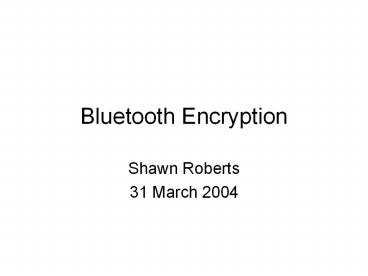Bluetooth Encryption - PowerPoint PPT Presentation
1 / 17
Title:
Bluetooth Encryption
Description:
Bluetooth Encryption. Shawn Roberts. 31 March 2004. What is Bluetooth ? ... Named after 10th Century Danish King Harald Bluetooth ... – PowerPoint PPT presentation
Number of Views:65
Avg rating:3.0/5.0
Title: Bluetooth Encryption
1
Bluetooth Encryption
- Shawn Roberts
- 31 March 2004
2
What is Bluetooth ?
- Created by Ericsson Mobile Communications
- Named after 10th Century Danish King Harald
Bluetooth - Standardized within the 802.15 Personal Area
Network (PAN) working group - 1988 Bluetooth SIG founded
- Founding members include Ericsson, Nokia, IBM,
Toshiba, Intel - Today over 2,000 participating companies
3
Bluetooth Physical Layer
- 2.4 to 2.4835 GHz (ISM band)
- Frequency hopping spread spectrum with time
division duplex - 1,600 hops/sec over 79 frequencies in
quasi-random fashion - Each 625 microsecond slot uses a different
frequency - Hop carriers equally spaced at 1 MHz intervals
4
Bluetooth Physical Characteristics
- Data Rate 1 Mbps
- Throughput 720 kbps (approx)
- Three classes of power management
- Class 1 100 milliwatt (mW) 100 meters
- Class 2 2.5 milliwatt (mW) 10 meters
- Class 3 1 milliwatt (mW) 1/10 to 10 meters
- 48 bit addresses
5
Bluetooth Networks
- Small adhoc Network consisting of up to 8
Bluetooth devices - One master and seven slaves
- Device can only be the master of one piconet at
the time - Device can switch between multiple piconets
- Scatternet-Consists of multiple piconets
6
Authentication Parameters
Parameter Length Secrecy Characteristic
Device Address 48 bit Public
Random Challenge 128 bit Public, unpredictable
Authentication 32 bit Public
Link Key 128 bit Secret
7
Bluetooth Keys
- Link keys
- All keys are 128bit random numbers and are either
temporary or semi-permanent - 4 Types
- Unit key KA -unique long-term private key of a
device - Combination key KAB -derived from units A and B.
Generated for each pair of devices - Master key Kmaster -used when master device wants
to transmit to several devices at once - Initialization key Kinit -used in the
initialization process.
8
Bluetooth Keys(2)
- Encryption key
- Derived from the current link key. Automatically
changed each time encryption is needed. - Separate from the authentication key
- PIN Code
- Fixed or selected by the user
- Usually 4 digits, can be 8 to 128 bits
- Shared secret
9
Bluetooth Key Generation
10
Bluetooth Authentication
11
Levels of Trust
- Trusted-If device B is trusted by device A it is
allowed unrestricted access to A - Untrusted-If B is untrusted by A it has
authenticated to A but access to A is limited - Unknown-If B is Unknown it has not been
authenticated and is unknown
12
Encryption Modes
- Mode 1 No encryption on any traffic
- Mode 2 Broadcast traffic (unencrypted)
- Individual Traffic encrypted with individual
link keys - Mode 3 All traffic encrypted according to
master link key
13
Bluetooth Encryption Process
14
Bluetooth Insecurities
- PIN weakness
- Initial authentication is based on a PIN that can
be anywhere between 8-128 bits. - If poorly chosen can be easy to guess
- Reflection Attack
- A hacker can capture the MIN and ESN and pretend
to be someone else - Stealing the Unit Key
- Highlights weakness of only authenticating the
device and not the user - Replay attacks
- A hacker can record Bluetooth transmissions in
all 79 frequencies and then in some way figure
out frequency hopping sequence and then replay
the whole transmission.
15
Bluetooth Insecurities(2)
- Man in the middle
- Bluetooth authentication does not use public key
certificates to authenticate users. - Denial-of-Service attack
- Not very feasible would require the jamming of
the whole ISM band
16
Securing your Bluetooth Device
- Pairing
- Weakest link and the most vulnerable to attack
- Should be performed in a secure area
- Use long Personal Identification Numbers
- Avoid using unit keys.
- Use combination keys instead
- Check the default settings of the device
- Respond only to inquiries of known devices
- Do not save PIN permanently in memory
17
Sources
- Bluetooth Stack Architecture Microsoft Windows CE
.NET 4.2 http//msdn.microsoft.com/library/default
.asp?url/library/en-us/wcebluet/html/ceconBluetoo
thStackArchitecture.asp - Gehrmann, Christian. Bluetooth Security White
Paper". Version 1.0 19 April 2002.
http//www.bluetooth.com/upload/24Security_paper.P
DF - Xydis, Ph.D. Thomas G. and Simon Blake-Wilson.
Security Comparison Bluetooth Communications
vs. 802.11, 10 November 2001, revised 15 May
2002. http/www.bluetooth.com/upload/14Bluetooth_W
ifi_Security.pdf - United States Dept. of Commerce. National
Institute of Standards and Technology. Technology
Administration. Special Publication
800-48Wireless Network Security802.11,Bluetooth
and Handheld Devices. By Tom Karygiannis
http//csrc.nist.gov/publications/nistpubs/800-48/
NIST_SP_800-48.pdf - Bluetooth Encryption Engine
- http//www.stanford.edu/jayasena/ee272/proj_desc.
htm
18
Bluetooth Protocol Stack































